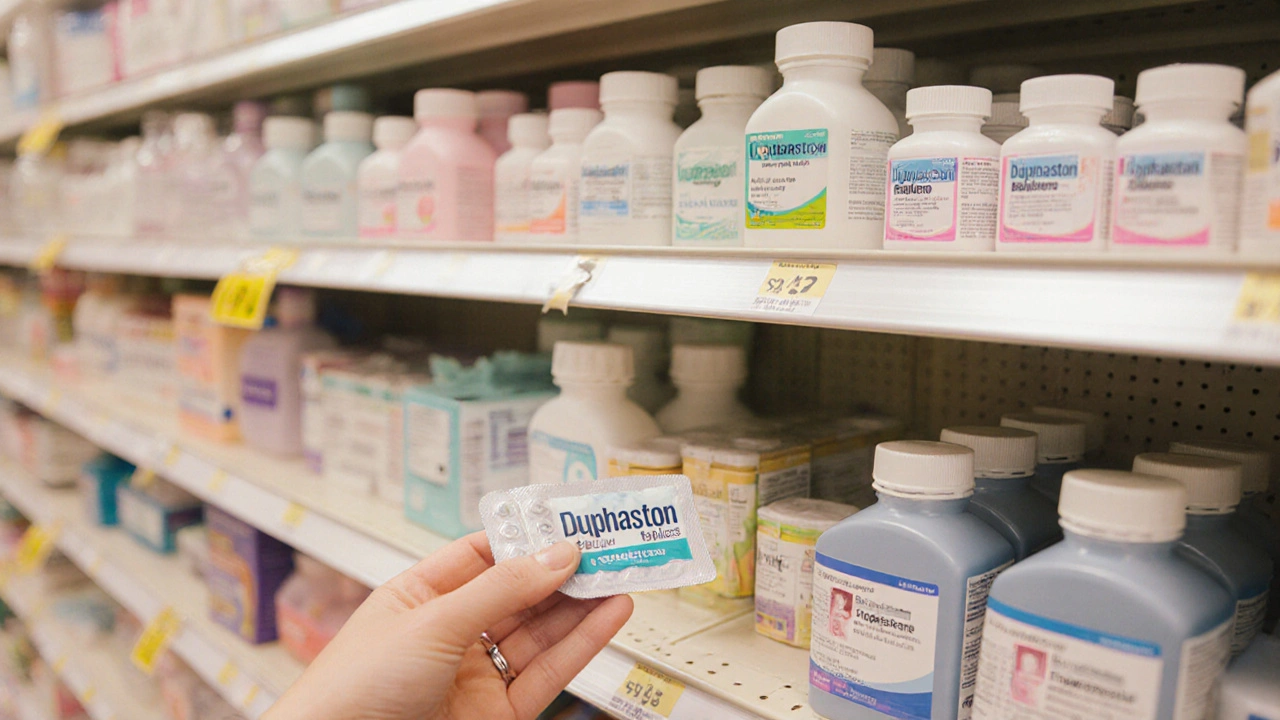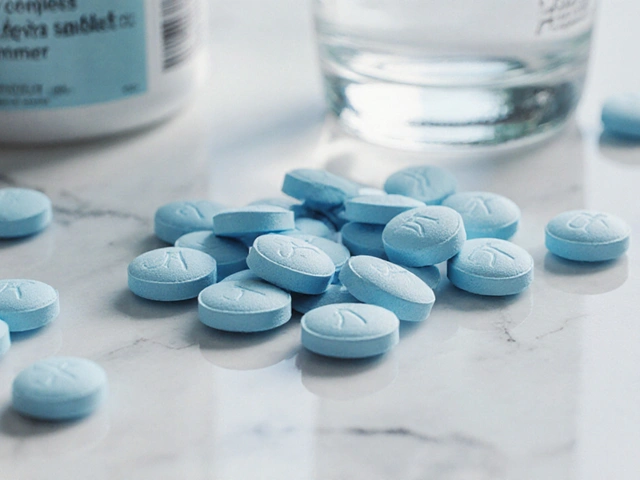
Progesterone Drug Comparison Tool
Select your conditions and preferences to compare progesterone options:
progesterone alternatives are a hot topic for anyone dealing with irregular periods, infertility, or menopausal symptoms. If you’ve been prescribed Duphaston and wonder whether another drug might suit you better, you’re in the right place. This guide breaks down the science, the side‑effect profile, and the everyday realities of Duphaston compared with the most common substitutes.
TL;DR
- Duphaston (dydrogesterone) is an oral synthetic progesterone with high receptor selectivity and a low androgenic side‑effect profile.
- Micronized progesterone (oral or vaginal) mimics natural progesterone but can cause drowsiness and requires multiple doses.
- Medroxyprogesterone acetate is a potent progestin used in HRT and contraception; it carries a higher risk of weight gain and blood‑clot issues.
- Norethisterone is a low‑dose oral progestin useful for menstrual‑cycle regulation but may increase acne and mood swings.
- Vaginal progesterone gel delivers the hormone directly to the uterus, ideal for luteal‑phase support in IVF cycles.
What is Duphaston?
Duphaston is a synthetic progesterone (dydrogesterone) taken orally to treat progesterone deficiency, irregular menstruation, and early‑pregnancy loss. It was first marketed in the 1960s and remains popular in Europe and Asia because it closely resembles natural progesterone while avoiding many of the side‑effects seen with older progestins.
How Duphaston Works
The active ingredient, dydrogesterone, binds selectively to the progesterone receptor (PR‑B) in the endometrium. This stabilises the uterine lining, reduces uterine contractility, and supports the secretory phase of the menstrual cycle. Because it does not strongly engage androgen or mineralocorticoid receptors, you’re less likely to experience acne, fluid retention, or blood‑pressure spikes compared with some other progestins.
Key Factors to Compare Progesterone Drugs
When you’re weighing Duphaston against other options, focus on these five criteria:
- Bioavailability and route - How much of the drug reaches the bloodstream, and does it need to be taken orally, vaginally, or by injection?
- Receptor selectivity - Does the molecule act only on progesterone receptors, or does it also trigger androgenic or glucocorticoid pathways?
- Side‑effect profile - Which adverse effects are common, and how severe are they?
- Clinical indication - Is the drug approved for menstrual disorders, luteal‑phase support, HRT, or contraception?
- Cost and availability - Is the medication covered by insurance in your country, and how easy is it to get?
Side‑By‑Side Comparison
| Drug | Active ingredient | Route | Typical dose | Bioavailability | FDA status | Common uses | Notable side effects |
|---|---|---|---|---|---|---|---|
| Duphaston | Dydrogesterone | Oral | 10‑30mg daily | ~70% | Approved in EU, not FDA‑approved | Menstrual disorders, luteal‑phase support, early pregnancy loss | Rare headache, mild nausea |
| Micronized progesterone | Progesterone (natural) | Oral / Vaginal | 100‑200mg oral or 200‑400mg vaginal | ~30% oral, >90% vaginal | FDA‑approved (Prometrium) | HRT, luteal‑phase support, menstrual regulation | Drowsiness, breast tenderness, constipation |
| Medroxyprogesterone acetate | Medroxyprogesterone acetate (MPA) | Oral / Injectable | 10‑20mg oral daily or 150mg IM every 3months | ~70% oral | FDA‑approved (Depo‑Provera) | Contraception, HRT, endometrial hyperplasia | Weight gain, mood swings, increased clot risk |
| Norethisterone | Norethisterone (norethindrone) | Oral | 5‑10mg daily | ~55% | FDA‑approved (Mareva) | Menstrual‑cycle control, endometriosis | Acne, breast enlargement, mood changes |
| Vaginal progesterone gel | Progesterone (micronized) | Vaginal | 90‑100mg daily (gel applicator) | >90% (local delivery) | FDA‑approved (Crinone) | Luteal‑phase support in IVF, early pregnancy | Local irritation, vaginal discharge |

Deep Dive into the Alternatives
Micronized Progesterone
Micronized progesterone is a bioidentical form of natural progesterone that can be taken orally or administered vaginally. Because it mirrors the body’s own hormone, it’s often recommended for women who want a “natural” HRT regimen. The oral form suffers from first‑pass metabolism, leading to lower systemic levels and the sleepy feeling many patients report. Vaginal tablets or gel bypass the liver, giving steadier uterine concentrations, which is why IVF clinics love it for luteal‑phase support.
Medroxyprogesterone Acetate (MPA)
Medroxyprogesterone acetate is a synthetic progestin with strong pro‑gestational activity and notable anti‑androgenic effects. It’s the workhorse behind many contraceptive injections and HRT formulas. While highly effective, the drug carries a higher propensity for weight gain, blood‑clot formation, and mood swings, especially in smokers or women over 35.
Norethisterone
Norethisterone is a first‑generation oral progestin used primarily for menstrual‑cycle regulation and treatment of endometriosis. Its modest potency makes it a good choice for mild symptoms, but the androgenic tail can aggravate acne and cause slight hair‑loss in predisposed users.
Vaginal Progesterone Gel
Vaginal progesterone gel is a gel formulation delivering micronized progesterone directly to the uterus via the vaginal mucosa. This route maximizes endometrial exposure while keeping systemic side effects low. It’s the preferred option for women undergoing IVF because it aligns closely with the timing of embryo transfer.
When Might Duphaston Be the Best Fit?
If you need a daily oral pill that feels “light” on the body, Duphaston shines. Its high receptor selectivity means fewer androgenic or mineralocorticoid side effects, which is a big win for women prone to bloating or acne. It’s also the go‑to for early‑pregnancy support because the dose is small enough not to disturb implantation yet strong enough to maintain the uterine lining.
Scenarios and Recommendations
- Irregular periods with mild symptoms: Start with Duphaston 10mg daily; if you experience headache, switch to micronized progesterone vaginally.
- Infertility treatment (IVF): Vaginal progesterone gel or micronized progesterone vaginal tablets provide the most reliable luteal support.
- Menopausal HRT: Medroxyprogesterone acetate offers strong protection against endometrial hyperplasia but monitor weight and clot risk.
- Endometriosis pain: Low‑dose norethisterone can reduce uterine‑contraction pain, though watch for mood changes.
- Patients with liver concerns: Oral dydrogesterone (Duphaston) has a lower hepatic metabolic burden than many older progestins.
Talking to Your Doctor
Bring these three questions to your next appointment:
- Which progesterone formulation aligns best with my specific diagnosis (e.g., luteal‑phase support vs. HRT)?
- What are the short‑ and long‑term side‑effect risks for each option?
- Will my insurance cover the drug, or should I consider a cost‑effective alternative?
Being armed with the comparison table above makes it easier for your clinician to explain why one drug might suit you better than another.
Next Steps & Troubleshooting
After you start a new progesterone regimen, give your body at least 2-3 menstrual cycles to assess effectiveness. If you notice persistent side effects-like severe headaches, unexplained weight gain, or mood swings-don’t wait for your next check‑up. Call your doctor early; a simple dose tweak or a switch to a different route (oral to vaginal, for example) can solve most problems.
Frequently Asked Questions
Is Duphaston safe during early pregnancy?
Clinical studies from Europe show that dydrogesterone (Duphaston) does not increase the risk of birth defects and is often prescribed to support the uterine lining during the first trimester. However, it’s still classified as a prescription‑only medication, so you need a doctor’s approval.
How does oral micronized progesterone differ from Duphaston?
Both are taken by mouth, but micronized progesterone is chemically identical to the body’s own hormone, leading to a lower risk of androgenic side effects. Its oral bioavailability is only about 30%, so higher doses are needed, which can cause drowsiness. Dydrogesterone has higher oral bioavailability and a cleaner side‑effect profile.
Can I switch from Duphaston to a vaginal gel without a wash‑out period?
Most doctors advise a short overlap (2‑3 days) to keep progesterone levels stable, especially if you’re using the medication for luteal‑phase support in IVF. The transition is usually smooth because the gel delivers the hormone directly to the uterus.
Why does medroxyprogesterone acetate cause more weight gain?
MPA has a stronger glucocorticoid activity, which can increase appetite and promote fluid retention. It also interacts with mineralocorticoid receptors, leading to sodium retention that shows up as weight gain.
Is norethisterone suitable for women with PCOS?
Norethisterone can help regulate periods in PCOS, but its mild androgenic effect might worsen acne or hirsutism. Many clinicians prefer a combination of low‑dose oral contraceptives plus a non‑androgenic progestin like dydrogesterone for PCOS patients.
What should I do if I miss a Duphaston dose?
Take the missed tablet as soon as you remember, unless it’s almost time for the next dose. In that case, skip the missed one and continue with the regular schedule - never double‑dose.
14 Comments
Write a comment
More Articles

Sexually Transmitted Infections in the LGBTQ+ Community: Risks and Prevention Strategies
In my recent exploration on the topic of Sexually Transmitted Infections (STIs) in the LGBTQ+ community, I found that this group faces unique risks and challenges. The stigma, discrimination, and lack of understanding can often lead to higher rates of STIs. The key to combating this issue is through informed prevention strategies, which include regular testing, protected sex, and open communication about sexual health. It's crucial that we work towards creating an environment where everyone feels safe and educated about their sexual health. Remember, knowledge is power when it comes to preventing STIs.



Angela Marie Hessenius
September 28, 2025 AT 07:54When we examine the landscape of progesterone therapy, it becomes clear that Duphaston occupies a unique niche that blends pharmacological precision with everyday practicality. The molecule, dydrogesterone, was first synthesized in the 1960s, yet its relevance persists in modern clinical practice across continents from Western Europe to the bustling clinics of Southeast Asia. One of the most compelling attributes is its high affinity for the progesterone receptor subtype B, which translates into a more physiological endometrial response while sparing patients from the androgenic excess that plagues many older progestins. Moreover, the oral bioavailability of roughly seventy percent allows for convenient once‑daily dosing, a factor that resonates with patients who juggle work, family, and health appointments. The side‑effect profile, characterized by occasional mild nausea or transient headaches, is notably milder than the weight‑gain and mood disturbances associated with medroxyprogesterone acetate. In comparative studies, women on Duphaston reported higher satisfaction scores, especially when the therapeutic goal was luteal‑phase support in assisted reproduction cycles. The drug’s low mineralocorticoid activity further reduces the risk of fluid retention, a common complaint among users of other synthetic progestins. From a cultural perspective, the acceptance of Duphaston in countries with strong traditions of natural‑product preference underscores its perceived “gentleness” compared with harsher synthetic alternatives. Clinicians often appreciate its predictable pharmacokinetics, which simplify the titration process and minimize the need for frequent laboratory monitoring. For patients with a history of acne or hirsutism, the non‑androgenic nature of dydrogesterone can be a decisive factor in maintaining dermatological stability. The drug’s safety record during early pregnancy has been reinforced by multiple European cohort studies, which found no increase in congenital anomalies relative to baseline rates. While the medication is not FDA‑approved, compounding pharmacies in the United States have facilitated access for those who have benefited from its use abroad. It is essential, however, for prescribers to discuss the off‑label status with patients, ensuring informed consent and alignment with insurance coverage realities. In contrast, micronized progesterone, though bioidentical, suffers from lower oral bioavailability and a propensity to induce somnolence, which can impair daytime functioning. Similarly, medroxyprogesterone acetate, while potent, carries a heightened risk of thrombosis, particularly in smokers or individuals over thirty‑five. Norethisterone’s modest androgenic activity may exacerbate acne in susceptible users, making it a less attractive option for those with polycystic ovary syndrome. Vaginal progesterone gels excel in delivering high uterine concentrations but may be less acceptable to patients who prefer oral regimens due to the inconvenience of applicators. Ultimately, the decision matrix hinges on individual symptomatology, side‑effect tolerance, route preference, and socioeconomic considerations. By weighing these dimensions thoughtfully, clinicians can harness the strengths of Duphaston while mitigating its limitations, thereby offering a tailored therapeutic pathway for each patient.